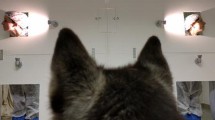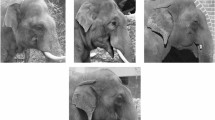Abstract
Faces have features characteristic of the identity, age and sex of an individual. In the context of social communication and social recognition in various animal species, facial information is relevant for discriminating between familiar and unfamiliar individuals. Here, we present two experiments aimed at testing the ability of cattle (Bos taurus) to visually discriminate between heads (including face views) of familiar and unfamiliar conspecifics represented as 2D images. In the first experiment, we observed the spontaneous behaviour of heifers when images of familiar and unfamiliar conspecifics were simultaneously presented. Our results show that heifers were more attracted towards the image of a familiar conspecific (i.e., it was chosen first, explored more, and given more attention) than towards the image of an unfamiliar one. In the second experiment, the ability to discriminate between images of familiar and unfamiliar conspecifics was tested using a food-rewarded instrumental conditioning procedure. Eight out of the nine heifers succeeded in discriminating between images of familiar and unfamiliar conspecifics and in generalizing on the first trial to a new pair of images of familiar and unfamiliar conspecifics, suggesting a categorization process of familiar versus unfamiliar conspecifics in cattle. Results of the first experiment and the observation of ear postures during the learning process, which was used as an index of the emotional state, provided information on picture processing in cattle and lead us to conclude that images of conspecifics were treated as representations of real individuals.




Similar content being viewed by others
References
Bouissou MF, Andrieu S (1978) Etablissement des relations préférentielles chez les bovins domestiques. Behaviour 64:148–157
Bouissou MF, Porter RH, Boyle L, Ferreira G (1996) Influence of a conspecific image of own vs. different breed on fear reactions of ewes. Behav Process 38:37–44
Bovet D, Vauclair J (2000) Picture recognition in animals and humans. Behav Brain Res 109:143–165
Charrier I, Mathevon N, Jouventin P (2001) Mother’s voice recognition by seal pups. Nature 412:87
Coulon M, Deputte BL, Heyman Y, Richard C, Delatouche L, Baudoin C (2007) Visual discrimination by heifers (Bos taurus) of their own species. J Comp Psychol 121:198–204
Coulon M, Deputte BL, Heyman Y, Baudoin C (2009) Individual recognition in domestic cattle (Bos taurus): evidence from 2D-images of heads from different breeds. PLoS ONE 4(2):e4441
Coulon M, Baudoin C, Abdi H, Heyman Y, Deputte BL (2010) Social behavior and kin discrimination in a mixed group of cloned and non cloned heifers (Bos taurus). Theriogenology 74:1596–1603
Cummins KA (1991) Olfactory and visual cues. Individual recognition and social aggression in lactating cows. J Dairy Sci 74:301
Dasser V (1987) Slides of group members as representations of real animals (Macaca fascicularis). Ethology 76:65–73
Dawkins MS (1996) Distance and social recognition in hens: implication for the use of photographs as social stimuli. Behaviour 133:663–680
Deputte BL (2000) Primate socialization revisited: theoretical and practical issues in social ontogeny. In: Slater PJB, Rosenblatt JS, Snowdon CT, Roper TJ (eds) Advances in the study of behaviour. Academic Press, San Diego, pp 99–157
Deputte BL (2010) Communication, perception et expression du chien. In: Bedossa T, Deputte BL (eds) Comportement et éducation du chien. Educagri Editions, Dijon, pp 355–424
Deputte BL, Pelletier S, Barbe S (2001) Visual categorization of natural and abstract items in forest monkeys and humans. Behav Process 55:51–64
Entsu S, Dohi H, Yamada A (1992) Visual acuity of cattle determined by the method of discrimination learning. Appl Anim Behav Sci 34:1–10
Fagot J (2000) Picture perception in animals. Psychology Press, Hove
Fagot J, Thompson RKR, Parron C (2010) How to read a picture: lessons from nonhuman primates. Proc Natl Acad Sci 107:519–520
Farah MJ, Wilson KD, Drain M, Tanaka JN (1998) What is “special” about face perception? Psychol Rev 105:482–498
Ferreira G, Keller M, Saint-Dizier H, Perrin G, Lévy F (2004) Transfer between views of conspecific faces at different ages or in different orientations by sheep. Behav Process 67:491–499
Freedman DJ, Riesenhuber M, Poggio T, Miller EK (2001) Categorical representation of visual stimuli in the primate prefrontal cortex. Science 291:312–316
Gheusi G, Bluthé RM, Goodall G, Dantzer R (1994) Social and individual recognition in rodents: methodological aspects and neurobiological bases. Behav Process 33:59–88
Gothard KM, Erickson CA, Amaral DG (2003) How do rhesus monkeys (Macaca mulatta) scan faces in a visual paired comparison task? Anim Cogn 7:25–36
Gothard KM, Brooks KN, Peterson MA (2009) Multiple perceptual strategies used by macaque monkeys for face recognition. Anim Cogn 12:155–167
Hagen K, Broom DM (2003) Cattle discriminate between individual familiar herd members in a learning experiment. Appl Anim Behav Sci 82:13–28
Herrnstein RJ (1990) Levels of stimulus control: a functional approach. Cognition 37:133–166
Hirata S, Fuwa K, Sugama K, Kusunoki K, Fujita S (2010) Facial perception of conspecifics: chimpanzees (Pan troglodytes) preferentially attend to proper orientation and open eyes. Anim Cogn 13:679–688
Houpt KA (2005) Domestic animal behavior for veterinarians and animal scientists. Blackwell, Oxford
Isingrini M, Lenoir A, Jaisson P (1985) Preimaginal learning as a basis of colony-brood recognition cues in the ant Cataglyphis cursor. Proc Natl Acad Sci 82:8545–8547
Kendrick KM (1998) Intelligent perception. Appl Anim Behav Sci 57:213–231
Kendrick KM, Baldwin BA (1987) Cells in temporal cortex of conscious sheep can respond preferentially to the sight of faces. Science 236:448–450
Kendrick KM, Atkins K, Hinton MR, Broad KD, Fabre-Nys C, Keverne B (1995) Facial and vocal discrimination in sheep. Anim Behav 49:1665–1676
Kendrick KM, Atkins K, Hinton MR, Heavens P, Keverne B (1996) Are faces special for sheep? Evidence from facial and object discrimination learning tests showing effects of inversion and social familiarity. Behav Process 38:19–35
Kendrick KM, Leigh AE, Peirce JW (2001) Behavioural and neural correlates of mental imagery in sheep using face recognition paradigms. Anim Welf 10:89–101
Lacreuse A, Martin-Malivel J, Lange HS, Herndon JG (2007) Effects of the menstrual cycle on looking preferences for faces in female rhesus monkeys. Anim Cogn 10:105–115
Lensink J, Leruste H, Tillie M (2006) L’observation du troupeau bovin : voir, interpréter, agir. France agricole, Paris
Lewkowicz DJ, Sowinski R, Place S (2008) The decline of cross-species intersensory perception in human infants: underlying mechanisms and its developmental persistence. Brain Res 1242:291–302
Marsh HL, MacDonald SE (2008) The use of perceptual features in categorization by orangutans (Pongo abelli). Anim Cogn 11:569–585
Moe RO, Bakken M, Kittilsen S, Kingsley-Smith H, Spruijt BM (2006) A note on reward-related behaviour and emotional expressions in farmed silver foxes (Vulpes vulpes) _Basis for a novel tool to study animal welfare. Appl Anim Behav Sci 101:362–368
Neiworth JJ, Hassett JM, Sylvester CJ (2007) Face processing in humans and new world monkeys: the influence of experiential and ecological factors. Anim Cogn 10:125–134
Parr LA, Heintz M (2008) Discrimination of faces and houses by rhesus monkeys: the role of stimulus expertise and rotation angle. Anim Cogn 11:467–474
Parr LA, Winslow JT, Hopkins WD (1999) Is the inversion effect in rhesus monkeys face-specific? Anim Cogn 2:123–129
Parr LA, Winslow JT, Hopkins WD, de Waal FBM (2000) Recognizing facial cues: individual discrimination by chimpanzees (Pan troglodytes) and rhesus monkeys (Macaca mulatta). J Comp Psychol 114:47–60
Parron C, Call J, Fagot J (2008) Behavioural responses to photographs by pictorially naïve baboons (Papio anubis), gorillas (Gorilla gorilla) and chimpanzees (Pan troglodytes). Behav Process 78:351–357
Pascalis O, de Haan M, Nelson CA (2002) Is face processing species specific during the first year of life? Science 296:1321–1323
Peirce JW, Kendrick KM (2000) Configurational coding, familiarity and the right hemisphere advantage for face recognition in sheep. Neuropsychologia 38:475–483
Phillips C (2002) Cattle behaviour. Farming Press, Ipswich
Pokorny JJ, de Waal FDM (2009) Monkeys recognize the faces of group mates in photographs. Proc Natl Acad Sci 106:21539–21543
Porter RH, Bouissou MF (1999) Discriminative responsiveness by lambs to visual images of conspecifics. Behav Process 48:101–110
Racca A, Amadei E, Ligout S, Guo K, Meints K, Mills D (2010) Discrimination of human and dog faces and inversion responses in domestic dogs (Canis familiaris). Anim Cogn 13:525–533
Reefmann N, Wechsler B, Gygax L (2009) Behavioural and physiological assessment of positive and negative emotion in sheep. Anim Behav 78:651–659
Rehkämper G, Görlach A (1997) Visual discrimination in adult dairy bulls. J Dairy Sci 80:1613–1621
Rosenfeld SA, Van Hoesen GW (1979) Face recognition in rhesus monkey. Neuropsychology 17:503–509
Sato S, Yoshikawa C (1996) Estimation of cognition pattern of cattle by the visual attention to photograph and movie images. Animal Sci Technol 67:36–42
Tate AJ, Fisher H, Leigh A, Kendrick KM (2006) Behavioural and neurophysiological evidence for face identity and face emotion processing in animals. Phys Trans R Soc B 361:2155–2172
Taylor AA, Davis H (1998) Individual humans as discriminative stimuli for cattle (Bos taurus). Appl Anim Behav Sci 58:13–21
Thom MD, Hurst JL (2004) Individual recognition by scent. Ann Zool Fenn 41:765–787
Thompson RKR (1995) Natural and relational concepts in animals. In: Roitblat HL, Meyer JA (eds) Comparative approaches to cognitive science. MIT Press, Cambridge, pp 175–224
Tibbetts EA (2002) Visual signals of individual identity in the wasp Polistes fuscatus. Proc R Soc Lond B 269:1423–1428
Tibbetts EA, Dale J (2007) Individual recognition: it is good to be different. Trends Ecol Evol 22:529–537
Van der Velden J, Zheng Y, Patullo BW, Macmillan DL (2008) Crayfish recognize the faces of fight opponents. PLoS ONE 3:e1695
Vauclair J, Fagot J (1996) Categorization of alphanumeric characters by Guinea baboons: within- and between-class stimulus discrimination. Curr Psychol Cogn 15:449–462
Waring GH (2003) Horse behaviour. Noyes Publications, Norwich
Wasserman EA, Kiedinger RE, Bhatt RS (1988) Conceptual behavior in pigeons: categories, subcategories, and pseudocategories. J Exp Psychol Anim Behav Process 14:235–246
Weiss DJ, Kralik JD, Hauser MD (2001) Face processing in cotton-top tamarins (Saguinus oedipus). Anim Cogn 4:191–205
Zangenehpour S, Ghazanfar AA, Lewkowicz DJ, Zatorre RJ (2009) Heterochrony and cross-species intersensory matching by infant vervet Monkeys. PLoS ONE 4(1):e4302
Zayan R (1994) Mental representations in the recognition of conspecific individuals. Behav Process 33:233–246
Zayan R, Vauclair J (1998) Categories as paradigms for comparative cognition. Behav Process 42:7–99
Acknowledgments
We thank the staff of the experimental farm UCEA-Bressonvilliers for special care to the animals, especially Laurent Delatouche and Christophe Richard (INRA UE 298 Unité commune d’expérimentation animale, F-91630 Leudeville). Thanks to Isabella Bollini for her help in the training of animals. We thank Prof. Hervé Abdi, Prof. Patrizia D’Ettorre and Prof. Charles T. Snowdon for their careful editing on the manuscript. This work was supported by a grant from the French Ministère de l’Enseignement et de la Recherche to M. Coulon.
Author information
Authors and Affiliations
Corresponding author
Rights and permissions
About this article
Cite this article
Coulon, M., Baudoin, C., Heyman, Y. et al. Cattle discriminate between familiar and unfamiliar conspecifics by using only head visual cues. Anim Cogn 14, 279–290 (2011). https://doi.org/10.1007/s10071-010-0361-6
Received:
Revised:
Accepted:
Published:
Issue Date:
DOI: https://doi.org/10.1007/s10071-010-0361-6




